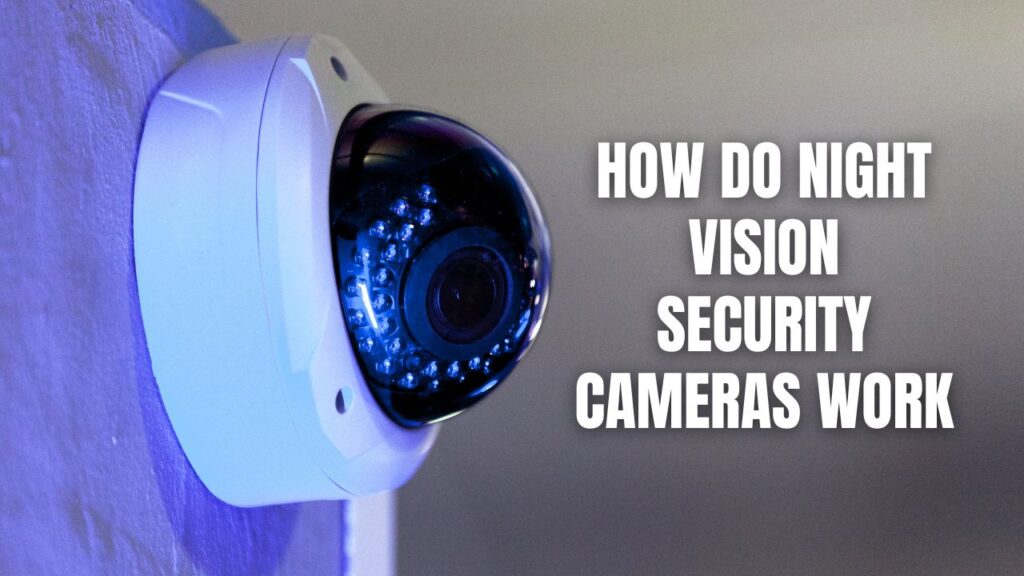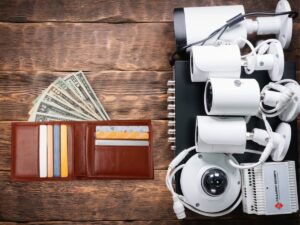Night vision security cameras operate using infrared (IR) technology to capture images and videos in low-light or completely dark environments. Unlike standard cameras that rely on visible light, night vision cameras utilize infrared LEDs, light-sensitive sensors, and image processing techniques to deliver clear footage even in pitch-black conditions.
Security is a 24/7 concern, and traditional cameras often fail when the sun goes down. This is where night vision security cameras come into play. These cameras are engineered to function seamlessly in complete darkness, making them essential for home security systems, business surveillance, and outdoor monitoring.
Key Takeaways:
- Night vision cameras use infrared (IR) light to capture images in darkness.
- Infrared LEDs act as invisible flashlights, illuminating the scene without visible light.
- Special image sensors, like CMOS or CCD, detect IR light and convert it into a visible image.
- An IR cut filter ensures accurate colors during the day and enables night vision at night.
- Some advanced models offer full-color night vision using low-light sensors and white light illumination.
- Night vision cameras can see up to 100-200 feet in complete darkness, depending on the model.
- They are commonly used in home security systems, businesses, and outdoor monitoring setups.

How Do Night Vision Security Cameras Capture Images in the Dark?
Step 1: Infrared Illumination
At night, security cameras activate their infrared LEDs, which emit infrared light that is invisible to the human eye but essential for the camera’s night vision function. These LEDs act like an invisible flashlight, flooding the monitored area with IR light.
Step 2: Light Detection and Image Processing
Infrared light reflects off objects and returns to the camera, where the image sensor (typically a CMOS or CCD sensor) detects and processes it. Since infrared light is outside the visible spectrum, the camera produces black-and-white images instead of color.
Step 3: IR Cut Filter Adjustment
During the day, an IR cut filter blocks infrared light to ensure colors appear natural. At night, this filter is automatically removed, allowing infrared light to reach the sensor and enabling night vision mode.
Step 4: Video Output
Once the sensor captures the infrared light, the camera’s processor converts it into a viewable image, often in grayscale. Some high-end models combine low-light technology with subtle white light to produce full-color images at night.
Types of Night Vision Security Cameras
1. Infrared (IR) Night Vision Cameras
These cameras rely on built-in IR LEDs to illuminate the surroundings and capture footage in total darkness. The images appear in black and white, ensuring clear visibility even with no ambient light.
Best For:
- Home security
- Outdoor surveillance
- Business security systems
2. Low-Light (Starlight) Night Vision Cameras
Starlight cameras use highly sensitive image sensors that can capture color images in very low-light conditions without relying on infrared illumination. These cameras work best in areas with some ambient light, such as streetlights or moonlight.
Best For:
- Large outdoor spaces
- Parking lots
- Warehouses
3. Full-Color Night Vision Cameras
Unlike traditional IR cameras, these models use a combination of low-light sensors and supplemental white LEDs to produce color footage at night.
Best For:
- Retail stores
- Homes with outdoor lighting
- High-security areas
How Far Can Night Vision Cameras See?
The viewing distance of a night vision security camera depends on:
- The strength of the IR illuminators
- The sensor’s light sensitivity
- The lens aperture
| Camera Type | Night Vision Range |
|---|---|
| Basic IR Cameras | 50-100 feet |
| Mid-Range IR Cameras | 100-150 feet |
| High-End IR Cameras | 200+ feet |
Additional Features That Enhance Night Vision Security Cameras
Motion Detection and Smart Alerts
Modern security cameras use motion sensors to trigger recording and send alerts when movement is detected in the dark.
Two-Way Audio
Some cameras come with built-in microphones and speakers, allowing users to communicate with visitors or warn off intruders in real-time.
Cloud and Local Storage Options
Recorded footage can be stored in cloud storage, SD cards, or external hard drives for future review.
AI-Powered Night Vision Enhancements
Advanced models use artificial intelligence (AI) and deep learning to reduce noise and improve clarity in low-light footage.
FAQs About Night Vision Security Cameras
Do night vision security cameras work through windows?
Infrared cameras may struggle to see through glass because IR light reflects off windows, causing glare. To record outside, it’s best to place the camera outdoors.
Can night vision cameras see in complete darkness?
Yes, IR night vision cameras can function in total darkness using built-in infrared LEDs.
How do I improve night vision camera quality?
- Position the camera away from direct light sources.
- Keep the lens clean.
- Choose a model with high-powered IR LEDs and a wide aperture.
Do night vision cameras work in foggy or rainy conditions?
Infrared light can be scattered by fog, rain, and dust, reducing clarity. Cameras with low-light sensors perform better in adverse weather.
Can I turn off night vision mode?
Most cameras allow users to manually disable IR night vision or switch to full-color mode if adequate lighting is available.
Why Night Vision Cameras Are Essential for Security
Night vision security cameras provide unmatched visibility in darkness, ensuring round-the-clock protection for homes and businesses. Whether using infrared, low-light, or full-color technology, these cameras help deter criminals, monitor activity, and provide peace of mind.
Investing in a high-quality night vision security camera enhances home security, workplace safety, and overall surveillance effectiveness. With advancements in AI, motion detection, and smart storage options, these cameras continue to evolve, making them a vital part of any modern security system.
Night vision security cameras are not just a luxury—they’re a necessity. Whether you’re securing your home, monitoring your business, or protecting outdoor areas, these cameras ensure that no movement goes unnoticed—even in total darkness. Contact Callaway Security™ if you’re around North and Central Georgia.












